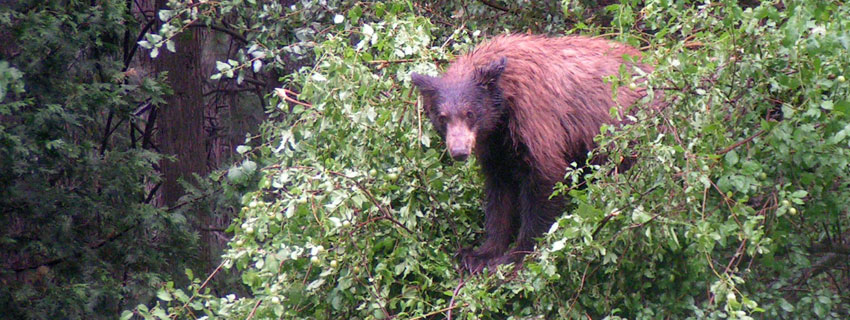Eating and Sleeping
Like humans, bears are omnivores, eating both plants and animals. The largest part of the Sierran black bears diet is vegetation. Meadow plants, grasses, and tender herbs are the most important food sources before berries, seeds, and nuts ripen in late summer. In autumn, acorns are critical to the bears’ desperate effort to gain the weight needed to survive winter, and bears can sometimes be spotted shaking acorns down from oak trees. If the winter is warm, and the acorn crop plentiful, some bears may remain active through the winter months, descending from the conifer forest to the oaks below.
Insects are a bear’s most important animal food. Bears in the Sierra regularly dig up yellow jacket nests and tear apart logs for carpenter ants. Black bears eat relatively little meat (unlike grizzlies), occasionally killing deer or eating the carrion left by other predators.
Black bears in the Sierra Nevada usually den from mid-December through March or early April, using natural caves in talus slopes, snow caves, and hollow trees or logs to make a winter den. This period is shorter than in areas with harsher winters. Bears able to find sufficient food don’t den at all, remaining active all winter, while others will hibernate for periods and leave the den at various points throughout the winter.
Hibernation of bears is different from other “true hibernators” such as bats, marmots, squirrels and rodents. These animals require several weeks to reach a state of dormancy during which their metabolic rate and body temperature drops many degrees below normal. During a black bear’s hibernation, its metabolic rate slows and its temperature may drop, but a safety mechanism prevents it from dropping too low. Once hibernating, bears do not eat, drink, urinate or defecate. They will change position while in the den, they may awaken and move about, and they may be aroused. Unique among mammals, black bears are able to recycle calcium back into their bones during hibernation, avoiding the erosion of bone (osteoporosis) that usually accompanies long periods of inactivity. Black bears will also slough their paw pads during hibernation.
